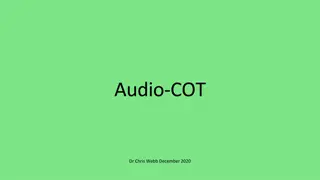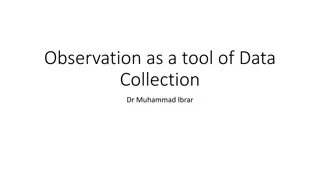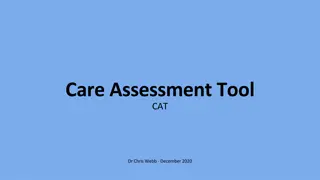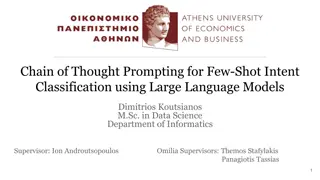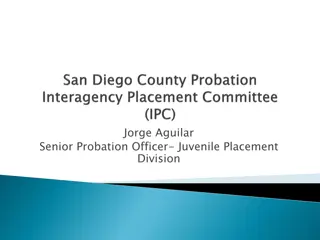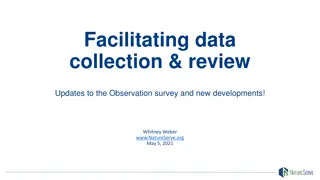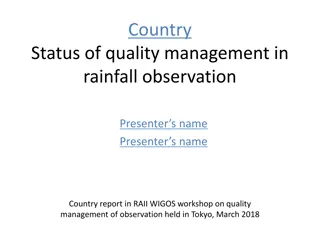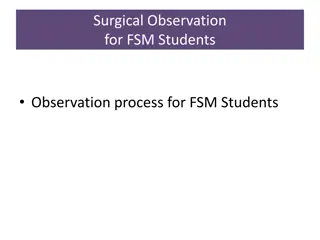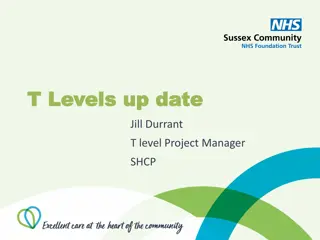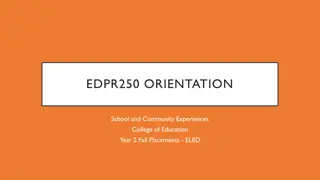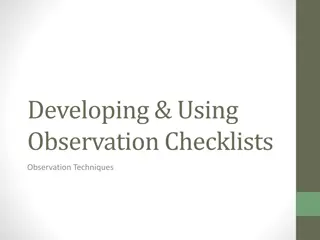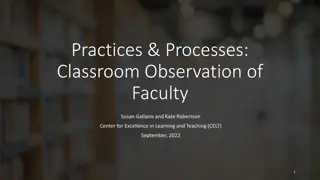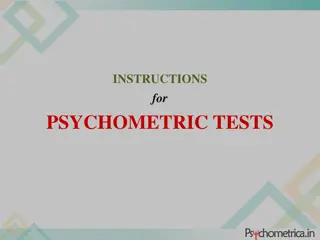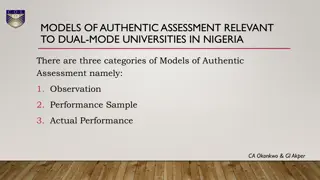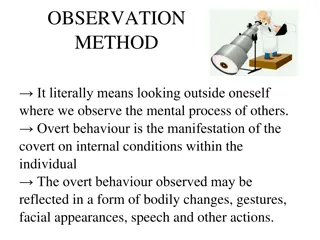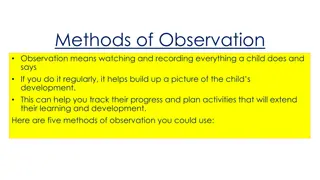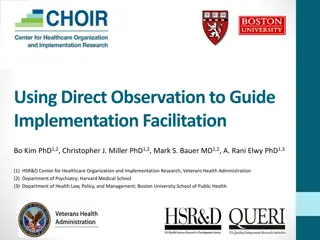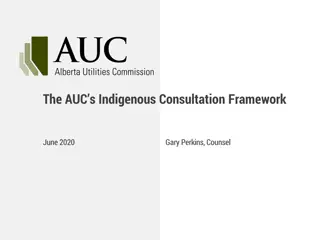Comprehensive Guide to Consultation Observation Tool (COT) in Primary Care Placements
The Consultation Observation Tool (COT) is essential for assessing trainees' clinical skills and professionalism during primary care placements. This tool evaluates their ability to consult effectively with real patients, emphasizing holistic judgments required for General Practice. Trainees must complete a certain number of COT assessments at different training levels. The process involves video recording consultations, obtaining patient consent, and selecting a variety of recorded consultations for assessment. Different assessment methods, such as face-to-face, video, or telephone consultations, can be used for the COT. Trainees are encouraged to reflect on their consultations to improve their skills. It is crucial to adhere to guidelines regarding evidence submission for assessments like the RCA and WPBA.
Download Presentation

Please find below an Image/Link to download the presentation.
The content on the website is provided AS IS for your information and personal use only. It may not be sold, licensed, or shared on other websites without obtaining consent from the author. Download presentation by click this link. If you encounter any issues during the download, it is possible that the publisher has removed the file from their server.
E N D
Presentation Transcript
Consultation Observation Tool COT Dr Chris Webb December 2020
The COT considers the trainees consultations with real patients in real time during their primary care placements. It assesses the clinical skills and professionalism necessary for good clinical care within their consultations and this includes their performance of the more holistic judgments needed to consult in General Practice
How many are needed? In ST1 and ST2 when in a primary care post 2 COTs need to be completed for each 6-month placement Some areas of the UK have 4 month primary care placements in ST1 and ST2. It is recommended that 2 COTs are also completed in these posts A total of 4 COTS/mini-CEXs are required in each training level in ST1 and ST2 7 COTs are required in the ST3 year. For trainees working less than full time these requirements will be pro-rata
How the COT works The trainees are encouraged to video record and then review their consultations as these are an essential way of improving their consultations The COT assessment can then be carried out using a recorded consultation; or they can arrange for their supervisor to observe their consulting directly The assessment can be completed using face to face, video or telephone (audio) consultations If a telephone consultation is being assessed then please use the Audio- COT assessment form and not the standard COT form
Selecting consultations Any consultations recorded will require the patient s consent. A sample consent form is available below The choice of consultations should cover the full breadth of Clinical Experience Groups and be in different settings, such as surgery consultations, home visits and Unscheduled urgent care / Out of Hours When selecting a recorded consultation, it is natural to choose one where the trainee feels they have performed well. Complex consultations or consultations that they found challenging are more likely to generate learning Please note that WPBA and RCA are independent components of the MRCGP Tripos and therefore evidence submitted for one assessment cannot also be used for the other. All recordings submitted for the RCA should not be utilised for evidence for WPBA. Similarly, a consultation that has previously been assessed e.g. as a COT or Audio-COT may not be submitted for the RCA as it has already been used as evidence for WPBA
Collecting evidence from the COT The trainee reviews the consultation with their supervisor, who will relate their observations to the WPBA Capability framework and COT or Audio-COT criteria The supervisor grades each section of the consultation, makes an overall judgement on performance and provides formal feedback with recommendations for further development
The doctor is seen to encourage the patients contribution at appropriate points in the consultation PC1 This Performance Criterion is particularly looking for evidence of a doctor s active listening skills, the ability to use open questions, to avoid unnecessary interruptions, and the use of non-verbal skills, in exploring and clarifying the patient s agenda Remember to think of the competences as active ones In many consultations there is little need to encourage; the patient comes in and states what the matter is, and the doctor may not necessarily be given credit for that You should seek for evidence that the doctor can encourage a contribution from a patient when encouragement is needed
The doctor is seen to respond to signals (cues) that lead to a deeper understanding of the problem PC2 The competence is to respond appropriately to important, significant (in terms of what emerges afterwards) cues Take account of non-verbal cues, if these are evident However, the doctor s response to a non-verbal cue may either be verbal (commenting that a patient seems upset, worried etc), non-verbal (use of silence) or active (a change in body posture, a touch to the patient, offering the patient a tissue) It is important that you are alert for these responses This PC certainly incorporates rapport and/or showing empathy , and if you notice an empathic response, consider whether it represents a response to a cue (i.e. the cue may be explicit, but the emotional significance that is being responded to may be quite subtle)
The doctor uses appropriate psychological and social information to place the complaint(s) in context PC3 We expect candidates to consider relevant psychological, social (including occupational) aspects of the problem These may be known beforehand, or offered spontaneously by the patient, or elicited The competence is to use the information in exploring the impact of the problem e.g. how does your backache affect your life as a builder It may also be appropriate to consider how the patient s lifestyle impacts on the problem
The doctor explores the patients health understanding PC4 This PC incorporates exploring the patient s perspective of the problem (including health beliefs and ideas, concerns and expectations ) Has (s)he read something on the internet, been told something...? The competence is the curiosity to find out what the patient really thinks - a cursory what do you think? without any response to the answer will not do. But questions like what did you think was going on...what would be your worst fear with these symptoms...were you concerned this was serious...what were you hoping I would do for this condition? are much more likely to get a valuable response
The doctor obtains sufficient information to include or exclude likely relevant significant conditions PC5 Trainees demonstrate this competence by asking questions around relevant hypotheses. It is important to remember the context of general practice, and especially that trainees are not (usually) specialist-generalists in any field This is the medical safety PC, which addresses the focused enquiry that commonly occurs during the consultation, not necessarily at a particular stage: it may happen during an examination, or later, during the explanation, or even as an afterthought This is an occasion when closed questions may be the most efficient method of obtaining the information, for example to determine whether or not a patient with headaches might have a serious illness such as raised intracranial pressure. It does not mean that the doctor has to go into every conceivable detail or chase rare diagnoses. Remember that it is part of the element obtain sufficient information about symptoms and details of medical history which in turn is part of defining the clinical problem(s). It is about taking a history in the degree of detail which is compatible with safety but which takes account of the epidemiological realities of general practice
The physical/mental examination chosen is likely to confirm or disprove hypotheses that could reasonably have been formed, OR is designed to address a patient s concern PC6 The competence will usually be the choice of examination, not the way it is done Video may not be the best place for that to be assessed - however it may generate discussion It is still usually possible to hear what examination is being undertaken and what explanations are being given A mental state examination would be appropriate in a number of cases Intimate examination should not be recorded!
The doctor appears to make a clinically appropriate working diagnosis PC7 Whilst this is included in the consultation summary form there should be evidence on the video of a clinically appropriate diagnosis or hypothesis having been made On occasions, however, it may not be possible to make a diagnosis, but discussion of what has been ruled out will be important
The doctor explains the problem or diagnosis in appropriate language PC8 There must be evidence of an explanation of the patient s problem. The element states that the findings should be shared with the patient. As educational supervisors we need to judge the quality of the explanation. A short explanation may be enough but it must be relevant, understandable and appropriate. Using diagrams or language aids for non-English-speaking patients may be appropriate Excellent trainees will incorporate some or all of the patients health beliefs - in other words, one that responds to the health beliefs considered in PC4. It is unlikely that this PC could be demonstrated in the absence of PC4. However, on occasion, the patient will volunteer their health belief without prompting Essentially it requires a reference back to patient-held ideas during the explanation of the problem/diagnosis
The management plan (including any prescription) is appropriate for the working diagnosis, reflecting a good understanding of modern accepted medical practice PC9 It is important that the management plan relates directly to the working diagnosis and must represent good current medical practice Management must be a safe plan even though it may not be what you would do Investigations and referral should be reasonable The prescribed medication (if any) should be safe and reasonable, even if not your preferred choice!
The patient is given the opportunity to be involved in significant management decisions PC10 This was formerly sharing management options - the new version seeks to reward the underlying competence of doctor and patient engaging in shared decision making Included in this competence is establishing the conditions for shared decision-making, such as the patient s willingness to be involved (at least a third are unwilling), their ability to take decisions (some are not able), and the evidence-base on which any decisions are being made The trainee should be rewarded for addressing any of these aspects of the competence: they do not need to take the patient right through to a decision
The doctor checks that there is a shared understanding of the diagnosis, management plan, treatment, safety-netting and follow-up arrangements PC11 A surprisingly high proportion of patients do not understand or remember what their doctors tell them about diagnosis or treatment. Cultural differences may exacerbate this. Uncertainty and lack of information or clear explanation can lead to patient anxiety and dissatisfaction. Feedback from patients suggests that information should not just be given but shared and made accessible so that they can enter into a discussion with the GP This competence is about ensuring, as appropriate to the individual patient, the accuracy of the patient s understanding of the diagnosis and management plan. It may be necessary overtly to check the patient s understanding of red flags and safety-netting, or of the follow- up arrangements and attention to medication compliance. A cursory Is that OK? or the patient simply nodding is not enough. It must be an active seeking out of the patient s understanding, agreement and an encouragement to accept appropriate responsibility It is essential that this should not be formulaic, but, if it is appropriate with the patient involved, phrases such as We ve covered a lot today, would you mind just running through our plan, so I can be sure we are in agreement? or Can I just check how you will take the medication and when? may be valuable
Makes effective use of resources PC12 Time management is important here. Was the consultation completed in 10 minutes? Providing Structure by summarising, signposting and sequencing, Aiding Recall and Understanding by restating, ...all of these are also important techniques This area will include use of resources to help those with disabilities, for example, or those patients whose first language is not English Referrals, investigations and follow-up appointments should be appropriate, being mindful of limited resources
The doctor specifies the conditions and interval for follow-up or review PC13 This criterion within the unit Make effective use of the consultation should be straightforward It should be interpreted broadly, so that any reference to returning ( next week , when the tablets run out , if not better in a few days , see the nurse for a BP check in 1 month , etc.) may be rewarded


